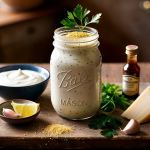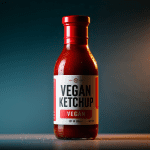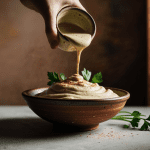Here’s a comprehensive overview of vegan mayo, including a simple recipe, tips for making it, and variations.
What is Vegan Mayo?
Vegan mayo is a plant-based alternative to traditional mayonnaise, typically made without eggs. It uses ingredients like plant-based milk, oil, and emulsifiers to achieve a creamy texture and flavor similar to conventional mayonnaise.
Basic Vegan Mayo Recipe
Ingredients
- ½ cup unsweetened soy milk (or aquafaba)
- 1 cup neutral vegetable oil (such as sunflower or canola)
- 1 teaspoon Dijon mustard
- 1 tablespoon apple cider vinegar (or lemon juice)
- ½ teaspoon salt (adjust to taste)
- Optional: minced garlic or garlic powder for added flavor
Instructions
- Combine Ingredients: In a tall jar or container, add the soy milk, Dijon mustard, vinegar, and salt.
- Add Oil: Pour the oil on top of the mixture.
- Blend: Using an immersion blender, blend the mixture starting at the bottom of the jar for about 15 seconds. Slowly lift the blender to incorporate all the oil until the mixture thickens and emulsifies (about 30 seconds total).
- Taste and Adjust: Taste the mayo and adjust seasoning if necessary. You can add more vinegar for tanginess or salt for flavor.
- Store: Transfer to an airtight container and refrigerate. It will thicken further as it chills.
Storage
Homemade vegan mayo can be stored in the refrigerator for about 1-2 weeks.
Tips for Making Vegan Mayo
- Use Room Temperature Ingredients: Ensure that all ingredients are at room temperature for better emulsification.
- Choose Your Oil Wisely: A neutral oil is recommended; avoid strong-flavored oils like extra virgin olive oil unless you want that flavor in your mayo.
- Experiment with Flavors: Add spices like smoked paprika or herbs for different flavor profiles.
Variations of Vegan Mayo
- Aquafaba Mayo: Substitute soy milk with aquafaba (the liquid from canned chickpeas) for a different texture.
- Spicy Mayo: Add sriracha or cayenne pepper for heat.
- Garlic Aioli: Incorporate more garlic or roasted garlic for a flavorful twist.
- Herbed Mayo: Mix in fresh or dried herbs like dill or basil for added freshness.
Uses for Vegan Mayo
Vegan mayo can be used in various dishes:
- As a spread on sandwiches and wraps.
- In salads like potato salad or coleslaw.
- As a base for dressings or dips.
- In recipes that call for traditional mayonnaise.
Here are detailed answers to your queries about making vegan mayo, based on the provided search results.
Best Oils to Use for Making Vegan Mayo
The best oils for making vegan mayo are neutral vegetable oils that won’t overpower the flavor. Recommended options include:
- Sunflower Oil: Provides a light flavor and good consistency.
- Canola Oil: Another neutral option that works well.
- Avocado Oil: Offers a slightly richer flavor while still being mild.
- Light Olive Oil: Use refined or light olive oil to avoid a strong taste; extra virgin olive oil can be too robust for mayo.
A common recommendation is to mix ¾ cup of a neutral oil (like sunflower or canola) with ¼ cup of olive oil for a balanced flavor profile.
Substituting Soy Milk with Another Plant-Based Milk
Yes, you can substitute soy milk with other plant-based milks for vegan mayo. Options include:
- Aquafaba: The liquid from canned chickpeas acts as an excellent emulsifier and can create a creamy texture similar to soy milk.
- Almond Milk: Unsweetened almond milk can also work, but it may have a slight nutty flavor.
- Oat Milk: This is another alternative, but ensure it’s unsweetened and plain.
Soy milk is often preferred due to its emulsifying properties, but these alternatives can work well too.
Making a Garlic-Free Version of Vegan Mayo
To make a garlic-free version of vegan mayo:
- Simply omit any garlic or garlic powder from the recipe.
- You can enhance flavor by adding extra mustard, lemon juice, or herbs like dill or parsley for a different taste profile without garlic.
Creative Ways to Use Homemade Vegan Mayo
Homemade vegan mayo is versatile and can be used in various ways:
- Sandwich Spread: Use it as a spread on sandwiches and wraps.
- Dips: Serve as a dip for veggies or chips.
- Salad Dressings: Mix it with vinegar and herbs for creamy dressings.
- Coleslaw: Combine with shredded cabbage and carrots for coleslaw.
- Pasta Salad: Use it as a base for pasta salads or potato salads.
How Long Does Homemade Vegan Mayo Last in the Fridge?
Homemade vegan mayo typically lasts about 1 to 2 weeks in the refrigerator. To maximize freshness, store it in an airtight container and check for any changes in smell or texture before use.
These tips should help you create delicious vegan mayo tailored to your preferences!
This easy-to-make vegan mayo is versatile and can enhance many dishes while being completely plant-based!



